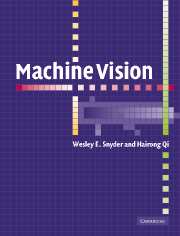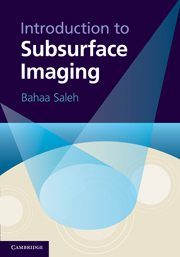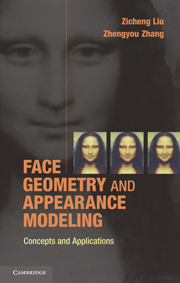Refine search
Actions for selected content:
526 results in Image processing and machine vision
Bibliography
-
- Book:
- Computer Vision
- Published online:
- 05 August 2012
- Print publication:
- 18 June 2012, pp 533-566
-
- Chapter
- Export citation
20 - Models for visual words
- from VI - Models for vision
-
- Book:
- Computer Vision
- Published online:
- 05 August 2012
- Print publication:
- 18 June 2012, pp 483-504
-
- Chapter
- Export citation
Acknowledgments
-
- Book:
- Computer Vision
- Published online:
- 05 August 2012
- Print publication:
- 18 June 2012, pp xiii-xiv
-
- Chapter
- Export citation
18 - Models for style and identity
- from VI - Models for vision
-
- Book:
- Computer Vision
- Published online:
- 05 August 2012
- Print publication:
- 18 June 2012, pp 424-452
-
- Chapter
- Export citation
Foreword by Andrew Fitzgibbon
-
-
- Book:
- Computer Vision
- Published online:
- 05 August 2012
- Print publication:
- 18 June 2012, pp xv-xvi
-
- Chapter
- Export citation
19 - Temporal models
- from VI - Models for vision
-
- Book:
- Computer Vision
- Published online:
- 05 August 2012
- Print publication:
- 18 June 2012, pp 453-482
-
- Chapter
- Export citation
17 - Models for shape
- from VI - Models for vision
-
- Book:
- Computer Vision
- Published online:
- 05 August 2012
- Print publication:
- 18 June 2012, pp 387-423
-
- Chapter
- Export citation
C - Linear algebra
- from VII - Appendices
-
- Book:
- Computer Vision
- Published online:
- 05 August 2012
- Print publication:
- 18 June 2012, pp 519-532
-
- Chapter
- Export citation
VI - Models for vision
-
- Book:
- Computer Vision
- Published online:
- 05 August 2012
- Print publication:
- 18 June 2012, pp 385-386
-
- Chapter
- Export citation

Machine Vision
-
- Published online:
- 05 June 2012
- Print publication:
- 08 January 2004

Introduction to Subsurface Imaging
-
- Published online:
- 05 June 2012
- Print publication:
- 17 March 2011

Face Geometry and Appearance Modeling
- Concepts and Applications
-
- Published online:
- 01 June 2011
- Print publication:
- 18 April 2011
PART II - FACE MODELING
-
- Book:
- Face Geometry and Appearance Modeling
- Published online:
- 01 June 2011
- Print publication:
- 18 April 2011, pp 41-42
-
- Chapter
- Export citation
Bibliography
-
- Book:
- Face Geometry and Appearance Modeling
- Published online:
- 01 June 2011
- Print publication:
- 18 April 2011, pp 279-294
-
- Chapter
- Export citation
Contents
-
- Book:
- Face Geometry and Appearance Modeling
- Published online:
- 01 June 2011
- Print publication:
- 18 April 2011, pp v-vi
-
- Chapter
- Export citation
PART III - APPLICATIONS
-
- Book:
- Face Geometry and Appearance Modeling
- Published online:
- 01 June 2011
- Print publication:
- 18 April 2011, pp 147-148
-
- Chapter
- Export citation
6 - Appearance modeling
- from PART II - FACE MODELING
-
- Book:
- Face Geometry and Appearance Modeling
- Published online:
- 01 June 2011
- Print publication:
- 18 April 2011, pp 86-110
-
- Chapter
- Export citation
3 - Appearance models
- from PART I - FACE REPRESENTATIONS
-
- Book:
- Face Geometry and Appearance Modeling
- Published online:
- 01 June 2011
- Print publication:
- 18 April 2011, pp 31-40
-
- Chapter
- Export citation
PART I - FACE REPRESENTATIONS
-
- Book:
- Face Geometry and Appearance Modeling
- Published online:
- 01 June 2011
- Print publication:
- 18 April 2011, pp 17-18
-
- Chapter
- Export citation
11 - Human computer interaction
- from PART III - APPLICATIONS
-
- Book:
- Face Geometry and Appearance Modeling
- Published online:
- 01 June 2011
- Print publication:
- 18 April 2011, pp 257-278
-
- Chapter
- Export citation
